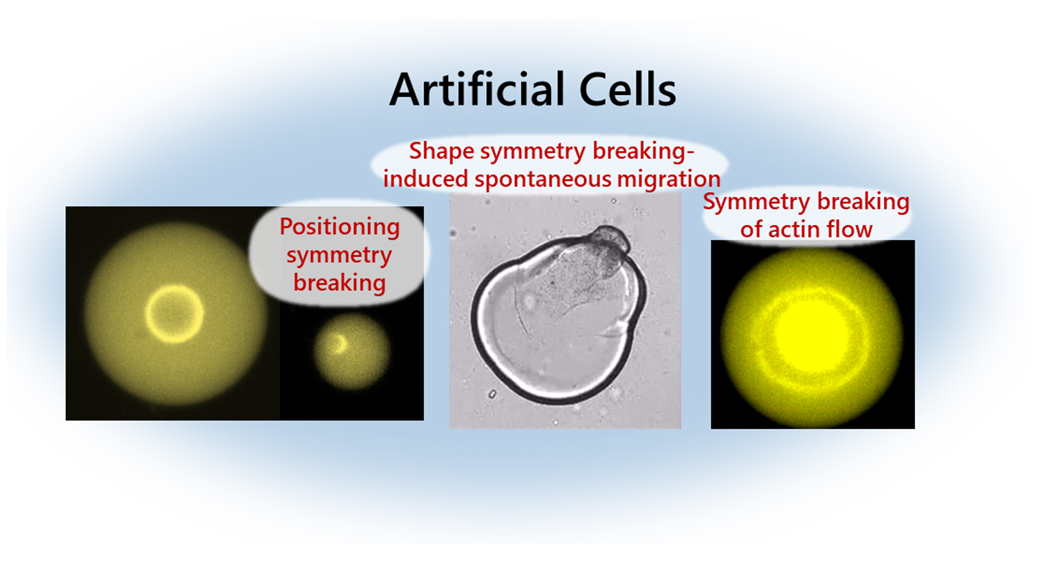- 著者
- Ryota Sakamoto Yusuke T. Maeda
- 出版者
- The Biophysical Society of Japan
- 雑誌
- Biophysics and Physicobiology (ISSN:21894779)
- 巻号頁・発行日
- vol.20, no.3, pp.e200032, 2023 (Released:2023-09-01)
- 参考文献数
- 52
Single-cell behaviors cover many biological functions, such as cell division during morphogenesis and tissue metastasis, and cell migration during cancer cell invasion and immune cell responses. Symmetry breaking of the positioning of organelles and the cell shape are often associated with these biological functions. One of the main players in symmetry breaking at the cellular scale is the actin cytoskeleton, comprising actin filaments and myosin motors that generate contractile forces. However, because the self-organization of the actomyosin network is regulated by the biochemical signaling in cells, how the mechanical contraction of the actin cytoskeleton induces diverse self-organized behaviors and drives the cell-scale symmetry breaking remains unclear. In recent times, to understand the physical underpinnings of the symmetry breaking exhibited in the actin cytoskeleton, artificial cell models encapsulating the cytoplasmic actomyosin networks covered with lipid monolayers have been developed. By decoupling the actomyosin mechanics from the complex biochemical signaling within living cells, this system allows one to study the self-organization of actomyosin networks confined in cell-sized spaces. We review the recent developments in the physics of confined actomyosin networks and provide future perspectives on the artificial cell-based approach. This review article is an extended version of the Japanese article, The Physical Principle of Cell Migration Under Confinement: Artificial Cell-based Bottom-up Approach, published in SEIBUTSU BUTSURI Vol. 63, p. 163–164 (2023).
- 著者
- Masa-aki Kishida Satoshi Muratsugu Ryota Sakamoto Tetsuro Kusamoto Hiroshi Nishihara
- 出版者
- (社)日本化学会
- 雑誌
- Chemistry Letters (ISSN:03667022)
- 巻号頁・発行日
- pp.121264, (Released:2013-03-19)
- 被引用文献数
- 7
We prepared dimethyldihydropyrene (DHP) derivative 2 which possesses two ferrocenyl groups at the 4 and 9 positions through ethynylene linkers. 2 showed intense electronic communication between the two ferrocenyl groups, which is promoted by the highly developed π-orbital of the diethynylDHP moiety.
- 著者
- Shoko Suzuki Ryota Sakamoto Hiroshi Nishihara
- 出版者
- (社)日本化学会
- 雑誌
- Chemistry Letters (ISSN:03667022)
- 巻号頁・発行日
- vol.42, no.1, pp.17-18, 2013-01-05 (Released:2012-12-22)
- 参考文献数
- 23
- 被引用文献数
- 3
[Ru(tpy)(picSO)]BF4 (tpy: 2,2′:6′,2′′-terpyridine, picSO: 6-[(methylsulfinyl)methyl]picolinate) undergoes profound linkage isomerization behavior between stable S-bound and metastable O-bound isomers. S-[RuII(tpy)(picSO)]BF4 experiences photoisomerization to O-[RuII(tpy)(picSO)]BF4 upon irradiation with 436 nm light, whereas the back reaction is triggered with 546 nm light. Electrochemical linkage isomerization also takes place.
- 著者
- Satoru Tsukada Ryota Sakamoto Hiroshi Nishihara
- 出版者
- The Chemical Society of Japan
- 雑誌
- Chemistry Letters (ISSN:03667022)
- 巻号頁・発行日
- vol.41, no.4, pp.357-359, 2012-04-05 (Released:2012-03-17)
- 参考文献数
- 43
- 被引用文献数
- 4
[{Cp*Rh(S2C6H4)}2W(CO)2] (Cp*: η5-C5Me5) (1) and [{Cp*Rh(S2C6H4)}(S2C6H4)W(CO)2] (2) were synthesized by the reaction of rhodadithiolene [Cp*Rh(S2C6H4)] with [W(CO)3(py)3], and their crystal structures and physical properties were investigated. The formation mechanism of 2 from 1 was pursued by 1H NMR spectroscopy. 1 reacted with an excess amount of BF3·Et2O to furnish 2, indicating that a Lewis acid assisted the demetalation reaction.
- 著者
- Ryota Sakamoto Koya Prabhakara Rao Hiroshi Nishihara
- 出版者
- The Chemical Society of Japan
- 雑誌
- Chemistry Letters (ISSN:03667022)
- 巻号頁・発行日
- vol.40, no.12, pp.1316-1326, 2011-12-05 (Released:2011-11-26)
- 参考文献数
- 94
- 被引用文献数
- 22
In this account we describe ethynylene-conjugated arylethynylanthraquinone (ArAq) and bis(arylethynyl)anthraquinone (Ar2Aq) which possess ferrocene, triarylamine, platinadithiolene complex, p-methoxybenzene, p-methylbenzene, m-methylbenzene, and benzene as electron-donating arenes (Ar), and anthraquinone (Aq) as an electron acceptor. This series of compounds features donor–acceptor (D–A) interactions: (1) Expression of intramolecular charge-transfer (ICT) transitions; (2) flexible single crystal networks constructed by intermolecular D–A π–π stacking, which undergo guest-induced reversible crystal-to-crystal transformations. In addition, ArAq and Ar2Aq experience proton-induced cyclization so as to produce pyrylium and dipyrylium salts. These salts feature further expanded π-conjugation and stronger D–A interaction: (1) More red-shifted ICT transitions and narrower HOMO–LUMO gaps; (2) bright fluorescence; (3) valence tautomerism (VT); (4) unique reactivities.

